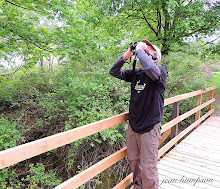Birding on the Selkirk Loop


Entering the Wildlife Management Area (WMA), Jean spotted a small brownish bird repeatedly bobbing its tail. A phoebe. Wait a minute! We're in the west though. That's a Say's Phoebe! Lifer # 273.
At the entrance to the visitor centre a board listed the wildlife sightings of the day. Of interest to Jean and I, a pair of Cinnamon Teal, a western species of waterfowl we needed for our life list. The staff informed us that the pair were in the pond at the front of the centre, along with a Sora and its young. Scanning the pond we found waterfowl, a female Wood Duck and Mallard, both with young, but not the lifer we sought.

The GPS batteries were very low and I could only use it minutes at a time. I estimate we hiked at least 3.5 kilometres while exploring this section of the WMA.
Scoping the pond at the rear of the centre we ticked American Wigeon and Ring-necked Duck, the lighting perfect for observing the "brown ring" on its neck.
 Swallows were everywhere. Sharing space on the structure of the visitor centre were Barn and Cliff Swallows. The Cliff Swallows preferred to build their mud nests beneath the rafters of the picnic area.
Swallows were everywhere. Sharing space on the structure of the visitor centre were Barn and Cliff Swallows. The Cliff Swallows preferred to build their mud nests beneath the rafters of the picnic area.Image by Bob
We walked along the Boardwalk Loop to the first observation tower and surveyed the waterways north of our location. A female Common Goldeneye with 8 young and a Great Blue Heron were seen.
From the Boardwalk Loop we continued our hike along the Marsh Trail.

Every nesting box we passed housed Tree Swallows raising their young.
There were many Red-winged Blackbirds in the WMA and a slightly larger blackbird, one with a yellow head soon caught our attention. Yes, a lifer Yellow-headed Blackbird (#274). We spotted its mate and an additional pair as they flew back and forth across the trail, most likely nest building. The birds held material in their beaks flying in one direction and would return with their beaks empty.

The Marsh Trail turned left, running along a tree line. Yellow Warbler called from the trees and brush to our right. A flycatcher, a nemesis flycatcher, would fly from tree to tree ensuring its species remained a tough bird to identify. Its call was heard earlier this year and we were sure we had a Willow Flycatcher. Our persistence to identify the Willow Flycatcher led us to spot our third lifer at the WMA, a female Black-headed Grosbeak (#275).
We turned off the Marsh Trail, walking under Highway 3 to reach the Trans Canada Trail and a second observation tower overlooking the northern section of the WMA.
As we emerged from beneath the overpass a large flycatcher flew from its perch on a small tree to capture a flying insect across the path. When it returned to its perch we identified the bird as a Western Kingbird (#276). Our fourth lifer of the day.














No comments:
Post a Comment